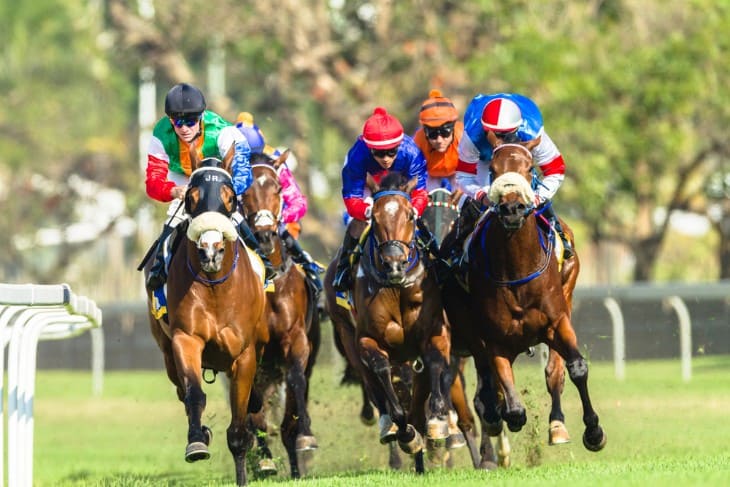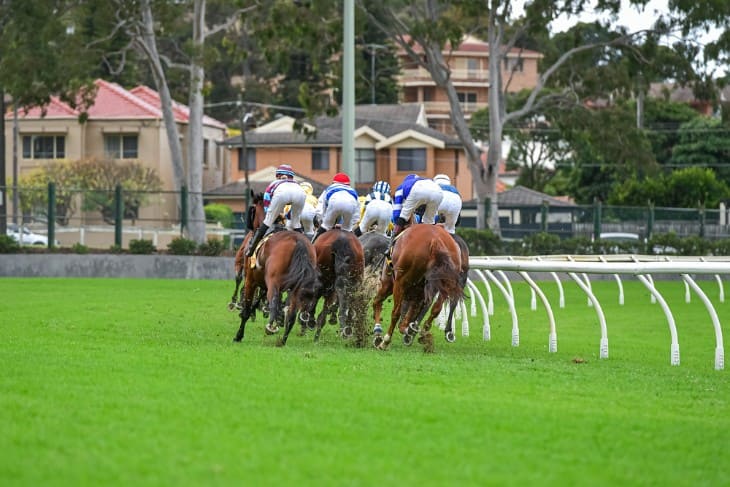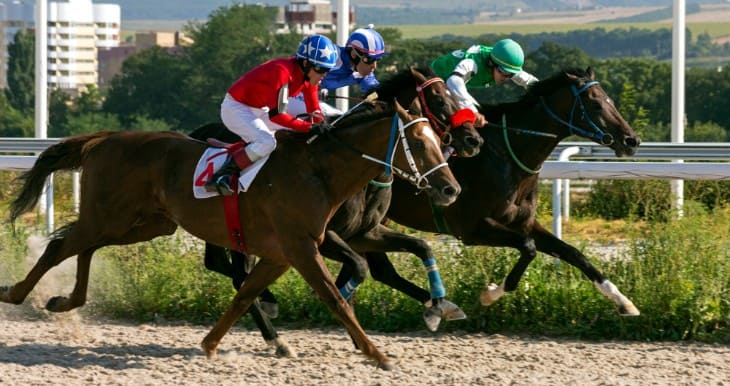- The Prestigious Thoroughbred: Racing Royalty
- The Agile Arabian: Elegance in Speed
- The Versatile Standardbred: Harness Racing's Hero
- The Spirited Quarter Horse: Sprints and Short Distances
- The Sturdy Appaloosa: Endurance and Toughness
- The Graceful Irish Sport Horse: A Multitalented Competitor
- The Mighty American Paint Horse: Beauty and Brawn on the Track
- The Exquisite Andalusian: A Heritage of Speed and Style
- The Agile Connemara Pony: Small Stature, Big Heart
- Conclusion
The Prestigious Thoroughbred: Racing Royalty
The Thoroughbred is considered racing royalty due to its unparalleled speed, competitive drive, and grace on the track. With origins tracing back to 17th century England, Thoroughbreds descend from three foundation Arabian stallions that were bred with native English mares to produce the modern breed.
Thoroughbreds are renowned for their tall, muscular frames; deep chests to house large hearts and lungs; and long, powerful legs. These physical gifts empower Thoroughbreds to gallop at over 40 miles per hour - no other breed can match their blistering pace. Their speed and agility also enable them to change pace and navigate tight turns with ease.
- Thoroughbreds have very fine coats that lie flat against their skin to reduce wind resistance when racing at high speeds. Their metallic sheen makes them appear as if they are chiseled from granite.
- To keep up with their high energy and calorie burn, Thoroughbreds must consume very high quality diets rich in calories and nutrients.
- Young Thoroughbred yearlings are put through a breaking-in process to prepare them for racing training and their future careers on the track. This includes being saddled, learning voice commands, and exposure to racetrack environments.
- Because they love to run by nature, Thoroughbreds require daily turnout and exercise to prevent behavioral issues from boredom or excess energy.
The Agile Arabian: Elegance in Speed
The Arabian breed is celebrated as the queen of endurance thanks to superior stamina developed from ancestors that traveled great desert expanses. Prized for refinement, beauty, and grace, Arabians carry themselves with an air of nobility.
Arabians boast distinctive physical traits like a concave facial profile, large expressive eyes, flared nostrils, and high-carried tails. Do not mistake their elegant appearance as weakness - they possess incredible strength and resilience. Their cardiovascular and respiratory systems are extremely efficient, allowing them to travel vast distances at a steady pace.
- To conserve moisture and energy, Arabians' skin produces very little oil which results in extremely fine, smooth coats.
- Selective breeding over thousands of years has made Arabians genetically predisposed to cooperation with humans. This allows remarkable bonds between Arabians and their riders.
- Mares pass on an exceptionally strong maternal instinct and nurturing temperament to their offspring.
- Arabians are so revered in the Middle East that the Bedouin people brought them inside their family tents and shared food directly from their hands.

The Versatile Standardbred: Harness Racing's Hero
The Standardbred is harness racing's most popular breed, valued for its reliability, toughness, and gentle nature. Developed in 18th century United States from Thoroughbreds breeds, Standardbreds earned their name by being able to trot a mile within a standard time frame.
Two traits make Standardbreds ideal for harness racing: an innate pacing or trotting gait and an exceptionally agreeable temperament. Their smooth, gliding gaits allow them to pull a two-wheeled sulky at speed while their calm and willing personality enables excellent communication with drivers. Trotting and pacing are natural gaits for Standardbreds.
- There are two types of Standardbreds: trotters that move with diagonal leg pairs; and pacers that move laterally with legs on the same side.
- Standardbreds possess broad chests and muscular hindquarters to generate pulling power. Their strength belies their generally petite stature.
- The breed established the iconic image of a harness racing horse outfitted with a sulky, helmet-wearing driver crouched behind in perfect sync.
- Standardbreds that leave harness racing find second careers as dependable riding horses thanks to their mild manners and smooth gaits.
The Spirited Quarter Horse: Sprints and Short Distances
For adrenaline-pumping action, Quarter Horse racing delivers with rapid sprints and bursts of acceleration. Taking their name from superior speed over a quarter-mile, Quarter Horses are the predominant breed racing short distances on straight courses.
Quarter Horses boast heavily muscled hindquarters which provide shocking acceleration from the starting gate; a low center of gravity for agility pivoting around tight turns; and a compact, powerful physique. Their explosive speed and sensitivity make them fantastic competitors when races are won by mere fractions of a second.
- Quarter Horses have been clocked at speeds over 55 mph at elite levels. However most race between 40-50 mph.
- Racing Quarter Horses must have outstanding temperaments to handle high stress of tight packs and contact.
- The American Quarter Horse Association sanctions races internationally and preserves the integrity of the breed.
- Quarter Horses dominate non-racing western performance events like reining, roping and ranch work due their strength and versatility
The Sturdy Appaloosa: Endurance and Toughness
Revered by Native Americans for its spotted coat patterns and formidable strength and stamina, the tough-as-nails Appaloosa thrives when tested by ultra long-distance endurance races across punishing terrain.
Appaloosas boast powerful, compact physiques; strong, short backs; and tough hooves that make them perfectly suited to traveling vast distances without tiring. Their shared history of adversity and battling challenging environments alongside Native American tribes has created an unshakable bond between the breed and its human partners.
- Each Appaloosa sports a utterly unique spotted coat pattern, ranging from snowcaps to vivid blankets. No two have identical markings.
- Appaloosas tend to have a calm yet curious temperament that makes them very amenable to training and human interaction.
- Along with endurance racing, Appaloosas excel at ranch work and roping events due their great strength and surefootedness.
- The Nez Perce people believed Appaloosas were sacred gifts from the Creator and treated them with enormous respect and honor.
The Graceful Irish Sport Horse: A Multitalented Competitor
The Irish Sport Horse, a Thoroughbred and Irish Draught cross, combines the best attributes of its parent breeds to create a supremely talented competitor in racing and beyond. With the speed and agility of a Thoroughbred paired with the resilience and work ethic of the Irish Draught, this breed proves itself in arenas worldwide.
Graceful in motion yet powerfully built, Irish Sport Horses have the stamina to be successful middle-distance racehorses. Their balanced conformation also prevents injury on the racetrack. Transitioning to disciplines like eventing and show jumping is seamless thanks to the breed's athleticism, bravery, and sound minds.
- Irish Sport Horses inherit natural self-carriage and elevated knee action from their Irish Draught bloodlines.
- Selective breeding focuses on improvement of both physical and mental traits to produce world-class performance horses.
- Irish Sport Horses have claimed Olympic and World Championship titles across multiple equestrian disciplines.
- After their sporting careers, many Irish Sport Horses have beloved second careers as steady riding horses and confidence-building teachers.
The Mighty American Paint Horse: Beauty and Brawn on the Track
No breed lights up the racetrack like the vibrant American Paint Horse steaming down the home stretch, its richly-colored coat patterns shimmering in motion. Athletic, willing, and wonderfully adaptable both mentally and physically, the handsome Paint reaches exceptional speeds over short distances.
On straightened quarter-mile tracks, American Paints unleash eye-popping acceleration and agility thanks to their muscular hindquarters and low center of gravity. Though they share ancestral links to Quarter Horses and Thoroughbreds, Paints have their own distinct look and temperament that sets them apart in the racing world.
- Modern breeding prioritizes optimal health and physical functionality to prevent genetically-linked health conditions. This enables Paints to realize their full athletic potential.
- The bold contrast of their dark and white coat markings makes Paints highly visible to racing fans in crowded grandstands.
- Paints that leave the track still have racing fire in their belly, making them fantastic gaming and rodeo mounts later in life thanks to their competitive drive.
- At the championship level, Paints consistently record winning times comparable to elite Quarter Horse and Thoroughbred athletes.

The Exquisite Andalusian: A Heritage of Speed and Style
A breed treasured for centuries by royalty and equestrians across Europe and beyond, the striking Andalusian conveys an air of nobility in both form and function. Though celebrated for fluid grace in classical dressage, Andalusians also flaunt impressive speed and agility as racehorses and historical cavalry mounts.
Andalusians cut dashing figures on the racetrack with their arched necks, elegantly curved profiles and full, flowing manes and tails that wave like banners as they charge down the home stretch. Their smooth transitions between collected gaits and open gallops highlight innate athletic prowess paired with stunning style.
- Passage and piaffe, signature movements in upper-level dressage, come naturally to Andalusians and display their exceptional balance and impulsion.
- Andalusians make fiercely loyal military horses that charge into battle without hesitation.
- Selective breeding over centuries has resulted in a genetically dominant grey coat color in about 80% of Andalusians.
- The breed is celebrated in art, classical literature, and performance as symbols of beauty, courage and nobility.
The Agile Connemara Pony: Small Stature, Big Heart
Hailing from Ireland's remote western seaboard, the hardy Connemara Pony may be compact in size but it possesses limitless heart and versatility. Connemaras race competitively against other ponies, show jumping with agility far beyond expectations, and serve as treasured family riding horses thanks to their willing temperaments.
Surefooted and nimble from a life roaming rugged mountain terrain, Connemaras move with athleticism belying their small equine package. Their gentle nature and eagerness to bond with humans make them the perfect choice for children to learn riding. With stamina inherited from their Arabian ancestors, Connemaras repeatedly prove big things come in small equine packages.
- Traits like intelligence, curiosity about their environment, and level-headedness equip Connemaras remarkably well for versatile careers.
- Adult Connemaras generally range between 13-15 hands high, though some stallions might reach up to 16 hands.
- Connemaras dominated the inaugural International Pony Show Jumping Championships, beating larger horses. Their dexterity and courage won admiration from spectators.
- Connemaras have served as loyal and steady mounts for British cavalry regiments like the King's Troop Royal Horse Artillery.
Conclusion
The world of horse racing provides a vibrant stage for many remarkable breeds to showcase their talents and competitive fire. From the blistering speed of the Thoroughbred, to the graceful endurance of the Arabian, to the gutsy determination of the Appaloosa, each breed adds its own flair and magic. Selective breeding over centuries and partnerships forged with humans have enhanced desirable racing attributes while preserving beloved characteristics unique to each breed. These magnificent equine athletes inspire awe and delight as they thunder down the home stretch, manes and tails flagging like victory banners announcing their competitive hearts. Their beauty, power and willingness to give their all for the thrill of the race reflect the incredible diversity of form and function from the equine world. Racing allows us to celebrate the profound human-horse bond and marvel at their spellbinding performances.








